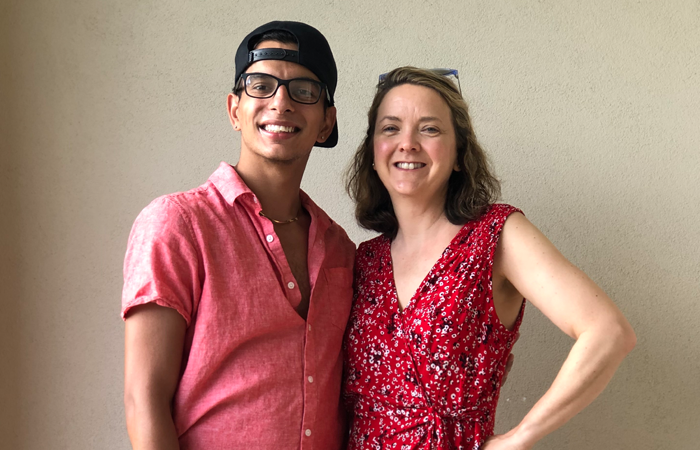“Brace for impact!”
We’ve all seen old Navy movies where the captain, spotting danger on the horizon, shouts, “Brace for impact!” The crew holds on for dear life as the ship careens wildly. When it’s all over, they brush themselves off and assess the damage. That’s how most parents approach that stage of a child’s life called “adolescence.”
When I conduct workshops on parenting adopted teens, almost all of the participants are either waiting families or the parents of toddlers. Puzzled, I once asked what had drawn them to the workshop so far in advance of their children’s teen years. “That’s just it,” one mother chimed up. “It’s daunting. We think about it from the beginning and wonder how we’ll weather the storm.”
The teenage years are intimidating for all parents, but they are a normal stage of child development. Adoption may add complexity to the primary task of adolescence — identity formation — but studies show that adoption does not automatically lead to increased pathology.
Instead, a useful approach to parenting adopted teens is to start from an understanding of normative child development, and then to add on the overlays of adoption, ethnicity, or culture. Think of adoption as simply another variation of family, much like “children raised in single-parent households” or “children of divorce.” While these situations add complexity, they do not change the fundamental tasks facing a child.
Who am I?
The primary task of adolescence is to form an identity. But what exactly does this mean? It means a separate and independent identity, a perceptible shift from the parental view to a personal one. Your parental authority comes into question right away because the first step in forming a personal view is to “bump up against” your world view.
My colleagues and I have noted that adolescence bears a strong resemblance to the “terrible twos.” In the toddler stage, children begin to realize that they are separate people from their parents, hence their affinity for the word “no.” What “no” really means is: “This is me and that is you.” Adolescents are learning that they have a separate identity, and they declare that autonomy in more sophisticated ways. (Although “no” may once again figure prominently in your child’s vocabulary.)
As parents, you must learn to “decode” the messages that your child is sending. Pay particular attention to the statements that end with “…but it’s no big deal.” Here’s an example offered by a 16-year-old Korean girl: “I wish I was taller, but it’s no big deal.” I wonder if, as a petite Asian growing up in the Midwest, she’s talking about more than height.
Who will love me?
Adolescence is about broadening one’s world. And a huge part of that is done through socializing and dating.
Many parents, however, operate under an erroneous assumption. They correctly understand that, as a child develops, the influence of peers increases and parental influence declines. However (and here’s the part many parents don’t know), according to research on adolescents, the two lines of influence don’t usually trade places, or even intersect. Each levels off, but parental influence tends to remain stronger, overall, than that of peers.
Parents should not jump to the hasty conclusion that they are no longer important and, accordingly, relinquish their power. As an adolescent’s world expands, it’s critical for parents to stay involved.
Dating is fraught with insecurities for all adolescents. For children from ethnic minorities, especially those raised in predominantly Caucasian homes and schools, dating can feel even more perilous. Adolescents in general fear that they are unattractive. And, unfortunately, in our society, attractiveness is still largely measured by Caucasian features, coloring, and proportions. So, for example, Asian girls may judge the lack of folds in their eyelids to be unattractive. Some transracially adopted teens may prefer to date only within minority groups because of a perceived fellowship based on existing “outside” the mainstream.
Many Caucasian parents feel at a loss when dealing with such issues. “The reality is,” one mother told me, “you don’t see your child’s color any more. I stopped seeing it long ago.” But now, to adequately parent teens of color, parents must see through fresh eyes — through their child’s eyes.
Make your values on dating and sex explicitly clear early on and then trust that parental influence, overall, tends to remain higher.
Who are they?
Because adolescence is characterized by the question “Who am I?,” one expression of this question may be a heightened interest in meeting birth parents. In 1994, the Search Institute conducted a study of 881 adolescents adopted as infants. Sixty-five percent said they would like to meet their birth parents.
Contrary to what you might assume, finding out “why I was adopted” [72 percent] was not number one. Instead, the top reason for wanting to meet birth parents was “to find out what they look like” [94 percent]. Upon reflection, this makes sense. Adolescents are preoccupied with physical appearance. Identity formation occurs by comparing ourselves to others, and, not surprisingly, this is a physical, as well as a psychological, process.
Adolescents want a physical yardstick. How tall will I be? Will I be plump? Skinny? Those of us who are raised in biological families make our assumptions without thinking, based on our biological parents. But adoptees often lack that physical marker, a picture in the mind’s eye of what they’ll look like.
The desire to meet birth parents leads to conversations about search. If your child brings it up, don’t jump to conclusions. It doesn’t mean your child is rejecting you or his family. It simply means that there are questions he wants the answers to as he solidifies his identity. Non-adopted teens get the answers to “Who am I?” by observing — and “bumping up” against — parents they know and see every day. But adolescents adopted internationally or in closed adoptions also have a set of “ghost parents.” Whom do they bump up against?
Searching is clearly not without emotional risks. It requires preparation for adoptees and parents alike. If searching comes up, remember that, most likely, the child is interested in something as simple and straightforward as what he or she will look like. Psychological reasons may not be as paramount in your child’s mind as you might assume. Nonetheless, it’s important to prepare thoroughly for whatever occurs as the result of a search.
Risky business
Adolescents need to belong and to feel accepted. They walk a razor sharp edge: “I want to be special, but I don’t want to be different.” To achieve this, they may act out sexually or engage in other risky behaviors, such as alcohol and tobacco use, in response to perceived pressure. It’s important for parents to be clear on where they stand on these matters.
Based on my professional experience, adoptive parents seem more reluctant than non-adoptive parents to intervene if they suspect their teenager is engaged in risky behaviors. I receive a lot of calls from adoptive parents who suspect their children are using alcohol or drugs or engaging in other risky behaviors. When I inquire if they have talked to their children about their suspicions, I routinely hear, “Well, I was hoping you would do that.” This may be because adoptive parents fear that, if they confront their child, they risk losing him or being told, “You’re not my real mother; you can’t tell me what to do.” But, as parents, it’s our responsibility to be resolute in our parenting. Don’t let the fact of adoption deter you from talking to your child if his behavior contradicts household rules or your family’s values.
If, however, your adolescent shows sudden, alarmingly risky behaviors, it is imperative to seek a medical or psychiatric opinion. In such a case, a clinical diagnosis may be warranted. While the majority of adopted teens do not need psychological help, don’t ignore the child who acts out inner feelings of turmoil through risky behaviors.
Whom to talk to?
A teen’s “new,” personal view lacks a strong foundation, so it’s common for adolescents, adopted or not, to have a hard time articulating what is going on. In an effort to be proactive, parents sometimes seek out a therapist. But unless your child is displaying risky behavior, you may be better served by seeking out an older adoptee to act as a mentor. Your child can relate to another adoptee, and the mentor can be sympathetic to feelings and experiences because she has had them, too. For a teen, the peer/mentor is less threatening and, often, more effective than one-on-one talk therapy. (If you have limited access to other adoptees, ask your agency to find a pen pal.)
Adolescents “flip-flop” between neediness and defiant independence, wanting their parents to go away and then wanting them close by, sometimes within minutes. Remember the ebb and flow of this behavior and that, even if your teen pushes you away today, it won’t be for good.
Parenting an adopted teen is both challenging and rewarding. You don’t necessarily have to brace for impact, but it does help to be prepared.
Read Part 2 here.



